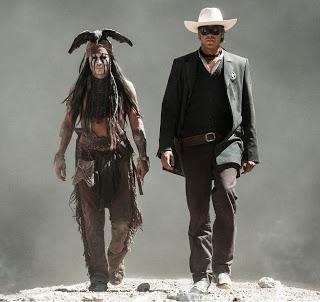
The Lowdown: Ah, the western. We meet again. With a few notable exceptions (True Grit, 3:10 to Yuma, Open Range), the western genre has largely been ignored in the past few years. A real shame, that. However, someone at Disney decided that it would be a good idea to make a western, and that it would be a good idea to reach as far back as 1933 to bring back The Lone Ranger, an American icon. After all, Disney has the money, talent, and resources to make a successful western; they brought back together Gore Verbinski and Johnny Depp, the dynamic duo from Pirates of the Caribbean and provided $200 million to get them started. How was the finished product? Well, for those who follow movies somewhat closely, Disney’s The Lone Ranger got trampled at the box office by Despicable Me 2 (2013) and has been nearly universally panned by critics. But I am here to say that this film is by no means bad. In fact, it is incredibly entertaining if uneven. Really, the film is a showcase of Verbinski’s directing talent, as he manages to weave intricate action setpieces and cinematic style in with a labyrinthine plot. The same could be said of the Pirates of the Caribbean films, the first three of which he directed. With that being said, The Lone Ranger is very much like a Pirates film, except it is set in the wild, Wild West. If you’re looking for a solid action-adventure or if you enjoy westerns, then The Lone Ranger is the film to see.
1. The Plot: The film opens up at the 1933 World’s Fair in San Francisco, where a kid stumbles upon a Wild West exhibit. Here, he meets Tonto (Johnny Depp), an incredibly old Native American who begins to recall the story of his adventures with John Reid, the Lone Ranger. John (Armie Hammer) is a young lawyer traveling back to Colby, Texas to visit his brother Dan (James Badge Dale), a Texas Ranger. However, it turns out that the train that John is riding is also transporting two outlaws: Tonto and the notorious Butch Cavendish (a snarling William Fichtner). Cavendish escapes custody with the help of his gang of ruffians, but John and Tonto survive. Dan vows to recapture Cavendish and deputizes John as extra help. However, Cavendish and his gang ambush the Texas Rangers and kill all of them except John, who is nursed back to health by Tonto. Wanting revenge for the death of his brother, John vows to find and bring Cavendish to justice. Tonto has a secret purpose for helping John as well.But wait, there's more! Other elements include the building of the Transcontinental Railroad, headed by Latham Cole (Tom Wilkinson), who may have a more sinister agenda. There is also Rebecca (Ruth Wilson) and Danny (Bryant Prince), the widow and son of Dan. It turns out that John has a past romantic history with Rebecca, because this film needed romance thrown into it. There is also Tonto’s story, which seems insignificant initially, but as the film progresses, turns out to fit in with the plot. Holy guacamole, there is a helluva lot going on in this film! Clearly, this film has an overstuffed and convoluted plot that may confuse people who came to see big action scenes involving guns, horses, and trains. It’s very much like one of the Pirates of the Caribbean films, which also might have caved a bit under the weight of everything happening in them. While The Lone Ranger’s 149 minute-long runtime is long enough to support a plot this big and complex, I can say that a few trims here and there wouldn’t have hurt the film. Still, Gore Verbinski is able to handle the plot very well. I was able to follow the storyline all the way through without getting lost, and pacing was hardly an issue. I’ve always been able to follow complex storylines, and The Lone Ranger was no exception. However, if you are one of the people who got a headache from the Pirates of the Caribbean films, then you might want to avoid The Lone Ranger.

We'll just pretend that On Stranger Tides never existed.
2. The Characters: The titular Lone Ranger is Armie Hammer, who got his start playing the Winklevoss twins in The Social Network. Since then, he seems to be rising in stardom. As John Reid, the lawyer, he is formal and wimpy, especially since he lives in the shadow of his brother. As the Lone Ranger…he doesn’t change too much. His character is likable, but remains somewhat bumbling for a good part of the film as he can’t get the wimpy lawyer out of him. There’s also plenty of comic relief to be had since he isn’t very good at being the hero. Johnny Depp (Pirates of the Caribbean, most Tim Burton movies), who plays Tonto, demonstrates for the millionth time that he is very good at playing quirky weirdos in his films. A running gag in the film is how Tonto constantly feeds the stuffed bird on his hat. Demeanor-wise, he is very much like, well, Johnny Depp. Being that this film is so similar to Pirates of the Caribbean, he is basically Jack Sparrow except he isn’t a pirate. He also isn’t actually Native American. Being friends with Gore Verbinski probably helped him get the role. No one was there to object either, since every real Native American that appears in the film dies. How convenient, and unsurprising for a Disney film.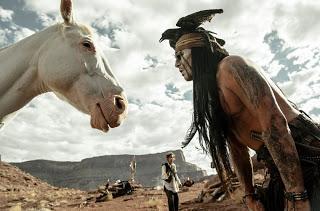
Can Johnny Depp not play a weirdo for once?
Butch Cavendish is played by William Fichtner (The Dark Knight), who chews the scenery as the sneering, sadistic criminal. Fichtner is very good at playing the villain; there isn’t a moment in the film where you don’t want Cavendish to get his comeuppance. His overacting may be off-putting to some, but I like it because it exaggerates him to the point where he almost isn’t believable. A more grounded, realistic performance might have resulted in an R-rating for the film.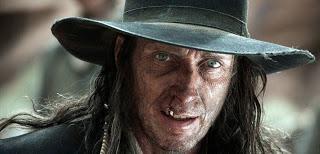
It couldn't be more obvious that he is the bad guy.
As far as supporting characters go, there are many. Another villain in the film is Latham Cole, played by Tom Wilkinson (Batman Begins). Being a railroad tycoon, he has an awful lot of power. Unlike Cavendish, Cole is a much more refined character, though it is made clear that Manifest Destiny isn't his ultimate goal. Rebecca, the widow of John’s brother, is played by Ruth Wilson (Anna Karenina), and her character doesn’t seem to function as much else but a damsel in distress who wants to protect her son. She is very good in the role, but there isn’t anything too memorable about her character. The other notable female character in the film is Red Harrington, played by Helena Bonham Carter (every Tim Burton movie from the last decade). Her character is a prostitute who has an ivory leg that doubles as a shotgun (don’t ask). She serves hardly any purpose and only appears in two scenes. Maybe Carter’s contract states that she must be shoehorned into any film with Johnny Depp. Because chemistry, I guess.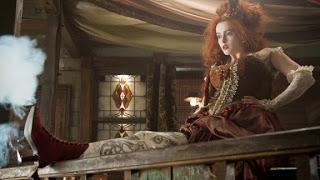
What the heck?
3. The Aesthetics: Gore Verbinski is one of the better visual directors working today. His Pirates films had a dirty aesthetic that made the films feel gritty and more intense. Also, who ever heard of clean pirates? Anyways, The Lone Ranger is set in the Wild West, and it is clear that Verbinski is paying homage to the visual style of classic westerns such as Once Upon A Time in the West by Sergio Leone. Aesthetically, Verbinski successfully captures the look and feel of the old West, from the yellow sun-bleached deserts to the dusty towns. Nature also plays a big part in the film, since huge rock formations, forests, and mountains are added for variety (there is quite a bit of desert in the film). The special effects in the film are great as usual for a Disney film. With a massive $250 million budget and special effects by Industrial Light & Magic, The Lone Ranger was in good hands. Big action sequences mostly involve trains, but these sequences are as enthralling and as well-rendered as any of the sequences in the Piratesfilms. The main difference is that everything looks cleaner because the action isn’t occurring on old pirate ships or in maelstroms.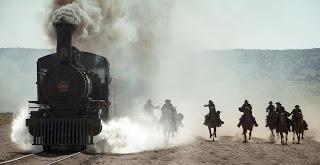
4. Disney and Obscurity: The Lone Ranger is currently failing at the box office. Why? It’s not because the film is bad, because it isn’t. I think it is because not that many people know who or what the Lone Ranger is. It started as a western series that debuted in the 1930s, so younger audiences might be all like, “Lone Ranger who?” This instantly limits the film’s audience to mainly older folks who can recall the days when westerns were still made. That said, Hollywood hardly makes westerns anymore. Most audiences today are used to seeing big-budget spectacles involving superheroes or giant robots, not horses and locomotives. Making a western and timing its release for July 4thwas definitely ‘Merican enough, but most likely, not as many people wanted to see The Lone Ranger. They would rather (and did) go to see Despicable Me 2. Basically, the problem was the film’s marketing. This is similar to the problem that John Carter, Disney’s last big flop, faced. I was one of those who asked “Who is John Carter?” It wasn’t until later that I found out that John Carter of Mars first showed up in the 1910s. Again, it flopped because it was too obscure for most audiences, and not because it was a bad film.
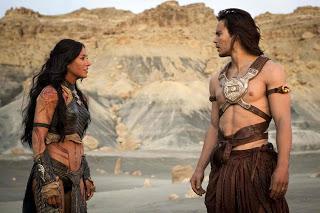
Although casting Taylor Kitsch may have hurt sales a bit.
Despite these huge losses for Disney however, they still continue to make films. Guess they have lots of money to blow.The Bottom Line:If you’re just a moviegoer looking for an action fix, or if you liked the Pirates of the Caribbean films, then The Lone Ranger should prove to be good summer entertainment. If you are a cineaste or a lover of westerns, then you may be able to appreciate Gore Verbinski’s loving homage to westerns. If you don’t like super-long movies, overstuffed plotlines, or borderline racial insensitivity, then you might not like the film as much. With all that being said, The Lone Ranger doesn’t deserve all the hate that it is getting. It’s actually a pretty good movie.
The Lone Rangeris property of Walt Disney Pictures, Jerry Bruckheimer Films, and Blind Wink Productions. This review was written by me.
Like the review? Post a comment. Like us on Facebook: http://www.facebook.com/filmaholicreviewsFollow us on Twitter: https://twitter.com/FilmaholicRvews
Copyright © Filmaholic Reviews, 2013
